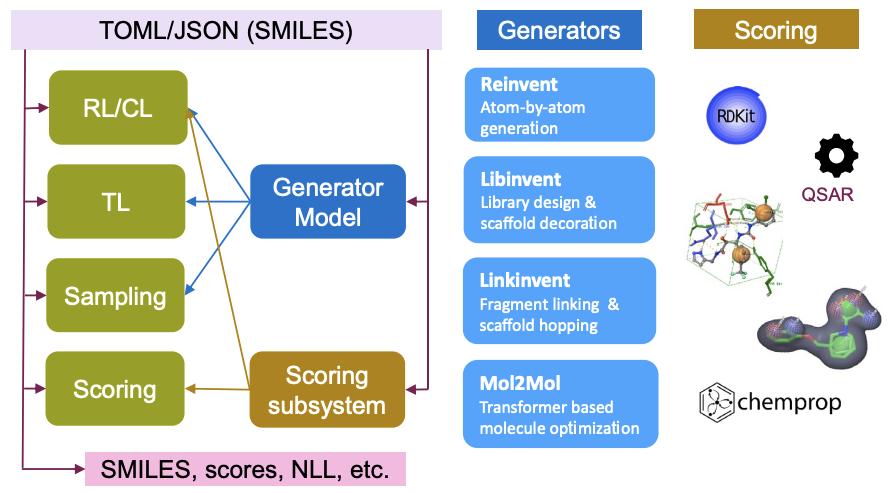Optimizing Drug Discovery Tools on AMD MI300X Part 1: Molecular Design with REINVENT#

This blog is part of a series of walkthroughs of Life Science AI models, stemming from this article which was a collaborative effort between AstraZeneca and AMD. The series delves into what was required in order to run drug discovery related AI workloads on AMD MI300X. This blog, in particular, looks at REINVENT4, a powerful molecular design tool that leverages advanced algorithms for de novo design, scaffold hopping, R-group replacement, linker design, and molecule optimization.
We show how minimal code changes can get you started, and we outline key steps to optimize such workloads on AMD hardware. The environment used was a TensorWave node with 8 MI300Xs.
REINVENT4 uses a Reinforcement Learning (RL) algorithm to generate optimized molecules according to a user-defined property profile expressed as a multi-component score. REINVENT4 supports multiple run modes (see Figure 1). In this blog, we focus on Transfer Learning (TL). TL can be used to create or pre-train a model that generates molecules closer to a set of input molecules.
Figure 1. Information flow in REINVENT4 for all run modes (green boxes) depicted in the left column.
Next, we will cover the steps required to create a Dockerfile to run REINVENT4 in a containerized environment and detail some optimizations that improve the performance on MI300X GPUs.
REINVENT4 Code#
REINVENT4 is developed on Linux, written in Python and uses PyTorch for neural network implementations. With PyTorch being supported by ROCm, REINVENT4 should be easy to run on AMD GPUs. REINVENT4 runs are defined in configuration files. Here, parameters such as run mode, hyperparameters, input files, etc. REINVENT4 also allows multiple run modes to be chained together and can be defined in a single configuration file.
Installation#
After looking at the repository installation steps, it seems to already
be supported on AMD hardware. There are even instructions for installing REINVENT4
on Windows and Mac. The installation seems straightforward enough. One
simply needs to clone the repository, create a Conda environment, and run
the install.py script which installs required packages using pip. This
method of installation allows the user to simply use the version of ROCm that
you have installed on your system (e.g. rocm6.2.4), and the installation
will install the specific PyTorch version compatible with ROCm. This set
of steps will allow you to quickly get started on a bare-metal machine.
To work on a Kubernetes cluster, we need a dockerizable recipe. The rest of the blog assumes working in such a cloud environment, so let’s get started.
Dockerizing REINVENT4#
The simplest way to work with ROCm and PyTorch installations is to use a
base image with these packages already installed. There are many
different versions that can be found here. The base image used was rocm/pytorch:rocm6.3.3_ubuntu22.04_py3.10_pytorch_release_2.2.1.
The authors propose in the README to run python install.py. This forces the installation of PyTorch, which would not work. The first approach to circumvent this was to source the required packages needed from the pyproject.toml file. They are found in that file under “dependencies” and were put in a requirements.txt file. This solution has the drawback of needing manual updates as the package list in the original repo is updated, which is undesirable. What was done instead was to add two lines in the Dockerfile to remove the torch and torchvision entries in the pyproject.toml. This then allowed for a REINVENT4 install as the authors intended:
# Remove torch and torchvision from pyproject.toml
RUN sed -i.bak '/torch==/d' pyproject.toml && \
sed -i.bak '/torchvision /d' pyproject.toml
One last thing before the Docker image is complete is to add some way for it to know what to run. This was done using an entrypoint-script:
#!/bin/bash
CONFIG_FILE="$1"
OUTPUT_FILE="$2"
# Check if OUTPUT ends with ".log" and append it if not
if [[ ! "$OUTPUT_FILE" =~ .log$ ]]; then
OUTPUT_FILE="${OUTPUT_FILE}.log"
fi
if [ -n "$CONFIG_FILE" ] && [ -n "$OUTPUT_FILE" ]; then
echo "Config file provided: $CONFIG_FILE"
echo "Output file provided: $OUTPUT_FILE"
echo "Running software in automated mode..."
# Set the correct permissions for the config file
chmod +r "$CONFIG_FILE"
exec reinvent -l "$OUTPUT_FILE" "$CONFIG_FILE"
echo "Processing complete. Results saved in $(dirname "$OUTPUT_FILE")."
else
echo "No config file or output file provided. Starting interactive mode..."
exec /bin/bash
fi
It allows for two parameters to be provided to the container: the config file and output file. If you need to debug the container or the code, no arguments can be provided and the container will spin up normally.
Finally, this is the Dockerfile:
FROM rocm/pytorch:rocm6.3.3_ubuntu22.04_py3.10_pytorch_release_2.2.1
# Use bash to support string substitution.
SHELL ["/bin/bash", "-o", "pipefail", "-c"]
RUN git clone https://github.com/MolecularAI/REINVENT4
WORKDIR REINVENT4
# Remove torch and torchvision from pyproject.toml
RUN sed -i.bak '/torch==/d' pyproject.toml && \
sed -i.bak '/torchvision /d' pyproject.toml
# Now run the install script as usual
RUN python install.py cpu
# Copy entrypoint script
COPY entrypoint.sh /
RUN chmod +x /entrypoint.sh
# Set the entrypoint script as default and allow passing parameters
ENTRYPOINT ["/entrypoint.sh"]
CMD ["", ""]
After the image is built, it can simply be run by:
docker run -d \
--device=/dev/kfd \
--device=/dev/dri/renderD<GPU_ID> \
-v $CONFIG_PATH:/data \
-v $OUTPUT_PATH:/output \
--name <container_name> \
<image name> \
<config_path\> \
<output_path\>
In the docker run command above, 2 volumes are mounted - one for the config path and one for outputs. You can also see that the last two arguments pass the config file and output path to REINVENT4.
Further simplifications to the docker run command can be made by preferring the Docker Compose tool. The main usage of Docker Compose is defining and running multi-container applications (such as a separate database and a UI for a web app), but it is also quite useful for managing single-container applications, especially when testing many different configurations to find the best solution. Here is the docker-compose file that was used:
services:
reinvent-benchmark:
build:
context: .
dockerfile: Dockerfile
network_mode: host
devices:
- /dev/kfd
- /dev/dri/renderD<GPU_ID>
group_add:
- video
security_opt:
- seccomp=unconfined
cap_add:
- SYS_PTRACE
tty: true
volumes:
- <config_dir>:/data
- <output_dir>:/output
command: ["/bin/bash", "-c", "reinvent -l <output_file> <config_file>"]
It can be run by:
docker compose -f docker-compose.yml up --build
Optimization#
The dataset used was ChEMBL35, which is an open source dataset of bioactive molecules with drug-like properties. As mentioned previously, the run mode primarily tested was TL (Transfer Learning), which can be seen as fine-tuning an existing model in the drug discovery space. The existing model (or prior model) was LSTM-based models of varying sizes. To further improve training performance on AMD GPUs, several optimization strategies were explored using the ChEMBL35 dataset in Transfer Learning (TL) mode with LSTM-based models. The goal was to identify changes that could accelerate training without compromising model quality.
PyTorch Automatic Mixed Precision (AMP)#
PyTorch’s Automatic Mixed Precision (AMP) package is a popular technique that automatically scales operations to use lower
precision formats (such as float16) while preserving accuracy. This
enables faster computations and decreases memory usage during training.
It simplifies the workflow by offering context managers and decorators,
such as autocast and GradScaler.
More practically, the _train_epoch_common function in REINVENT4/reinvent/runmodes/TL/learning.py was modified using PyTorch GradScaler as follows:
def _train_epoch_common(self) -> float:
"""Run one epoch of training
:returns: mean negative log likelihood over all SMILES
"""
scaler = torch.GradScaler()
mean_epoch_nlls = np.zeros(len(self.dataloader))
for step, batch in enumerate(self.dataloader):
with torch.autocast(
"cuda:0", enabled=os.environ.get("__AUTOCAST", "0") == "1"):
nll = self.compute_nll(batch)
loss = nll.mean()
mean_epoch_nlls[step] = loss.item()
self._optimizer.zero_grad(set_to_none=True)
scaler.scale(loss).backward()
if self.clip_gradient_norm > 0:
scaler.unscale_(self._optimizer)
clip_grad_norm_(
self.model.network.parameters(), self.clip_gradient_norm
)
scaler.step(self._optimizer)
scaler.update()
self._lr_scheduler.step() # Mol2Mol does this once per batch
return mean_epoch_nlls.mean()
This AMP implementation worked out-of-the-box, with observed training time reductions of 10–60%.
Explored but Unproductive Optimizations#
MIOpen, AMD’s deep learning library, offers auto-tuning via MIOPEN_FIND_MODE and MIOPEN_FIND_ENFORCE. Enabling these did not improve speed, likely because auto-tuning mainly benefits convolutional layers, which are not the primary component of the models.
PyTorch’s torch.compile and TunableOp features also showed no speedup beyond what Automatic Mixed Precision (AMP) provided. For this workload, AMP delivered the main performance gains, while further optimizations had minimal impact.
Summary#
The Transfer Learning (TL) run mode of the REINVENT4 package ran seamlessly out-of-the-box on an AMD MI300X with no code change or engineering effort required. Further improvements can be achieved by enabling Automatic Mixed Precision. This change reduced training time by 10-60%. Significant gains in speed were also observed when increasing the batch size.
For more information about Life Science AI models on AMD hardware, check out the original article and stay tuned for the second blog in this series, which discusses SemlaFlow, another molecular generation model used in drug discovery workflows.
Additional Resources#
The official REINVENT4 repo can be found here.
The official REINVENT4 paper can be found here.
Disclaimers#
Third-party content is licensed to you directly by the third party that owns the content and is not licensed to you by AMD. ALL LINKED THIRD-PARTY CONTENT IS PROVIDED “AS IS” WITHOUT A WARRANTY OF ANY KIND. USE OF SUCH THIRD-PARTY CONTENT IS DONE AT YOUR SOLE DISCRETION AND UNDER NO CIRCUMSTANCES WILL AMD BE LIABLE TO YOU FOR ANY THIRD-PARTY CONTENT. YOU ASSUME ALL RISK AND ARE SOLELY RESPONSIBLE FOR ANY DAMAGES THAT MAY ARISE FROM YOUR USE OF THIRD-PARTY CONTENT.
